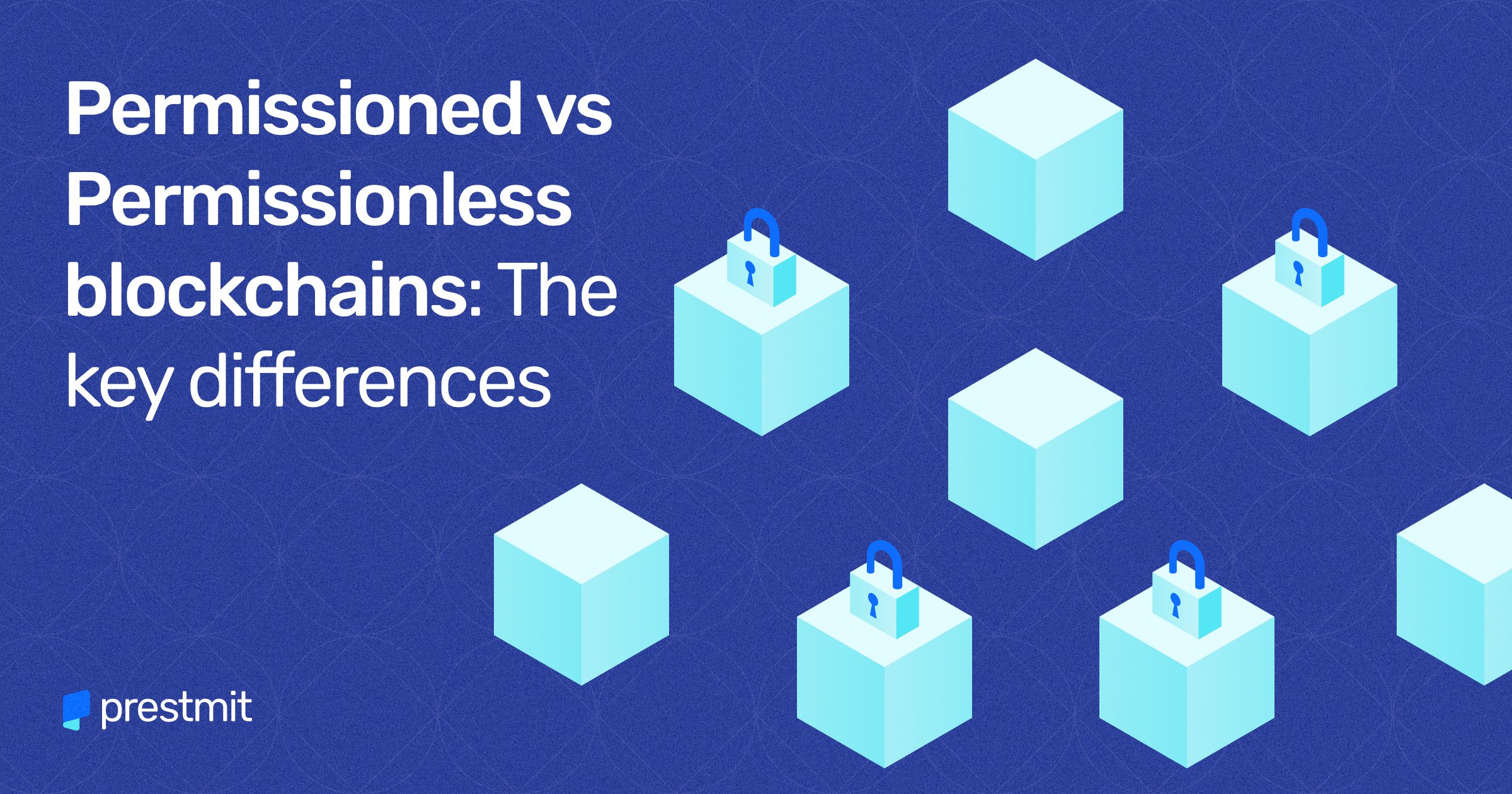Table of Contents
The applications of blockchain technology continue to be evident in different industries. This is due to its scalability and immutability towards recording transactions and data storage. But as blockchains have different distributed design versions and technologies that impacts global digital economy, we will look at the key differences between permissioned and permissionless blockchains, two (2) popular versions of the blockchain.
What Are Permissioned Blockchains?

A permissioned blockchain is a closed network that exclusively grants access to a selected number of users. This blockchain often has an access control layer, and ledger administrators regulate permissions on the ledger. Users typically have login details and defined roles. The roles determine the type of information they can access and how to manipulate it.
Permissioned blockchains are designed to offer the benefits of distributed ledger technologies (DLTs) with a high level of centralization.
Characteristics Of Permissioned Blockchain
1. Less Transparency
The sole aim of a permissioned aim is privacy. As such, these chain owners can determine the information their users can access or manipulate. Permission chains reduce access to transaction records, including the identities of the individuals who broadcast the transactions to users with permissions.
2. Access Control Layer
Permissioned chains have additional security layers that strictly give different permissions to users. Therefore, only authorized users can access a permissioned network.
3. Consensus Mechanism
Permissioned chains have different consensus algorithms. These networks use Federated Byzantine Consensus (FBC), Practical Byzantine Fault Tolerance (PBFT), or Round-robin consensus mechanisms to verify the network’s transactions and information.
Advantages And Disadvantages Of Permissioned Blockchains
There are many benefits and drawbacks associated with permissioned blockchains.
Pros:
- Cost Effective: The chains are highly effective as they require a few nodes to reduce operational costs. They have a limited user base, which scales down the infrastructure requirements and costs.
- Efficient Performance: Permissioned chains need fewer nodes on their network due to the nature of their consensus validation. As such, this reduces computations per transaction to make them more efficient.
- Good Governance Structure: These chains have a clear governance structure due to their central authority. The network’s administrators develop a hierarchical system that makes changes and updates efficient.
Cons:
- Compromised Security: The integrity of the permissioned blockchain lies in the administrators’ integrity. Therefore, it is easy for administrators or private entities on private networks to breach security or manipulate the data in the blockchain – leading to the compromise of the chain’s protection.
- Centralization: This is a partially decentralized chain, although it offers the benefits of a decentralized ledger technology (DLT). A few individuals can access the important features – enabling them to run the chain as they choose. So, this defeats the decentralized nature of blockchain technology.
- Susceptibility to censorship: There is much human influence on the permissioned blockchain’s performance since it is privately regulated. It can lead to administrators keeping essential information from users or playing favoritism in managing users’ transactions.
Use Cases Of Permissioned Blockchain
Permissioned blockchains are efficient in sectors with a large volume of data, including sensitive information that must be away from public access. Here are some of the industries where its application is important:
- Banking and financial institutions: To store transaction data of customers and verify transactions.
- Healthcare and life science: Store health research data and patient medical records.
- Supply chains: For storing distributed and stored products or available services.
- Manufacturing: To document and store manufacturing processes, ingredients, and workflow.
What Are Permissionless Blockchains?

Permissionless blockchains are open networks available to everyone to participate in the consensus process of validating transactions and data by the blockchain. They have a complete decentralization across all parties. This chain allows users to create a personal address – usernames or account profiles that link with email addresses. They can then use the account to interact to interact with the network.
Some popular permissionless blockchains are Bitcoin, Ethereum, Avalanche, Solana, and Polygon. Almost anybody can join, send, or receive transactions, store information, run a node, and contribute to the chain.
Characteristics Of Permissionless Blockchain
1. Immutability
It is impossible to alter or delete data stored on this blockchain. It is also tamper-proof as it enables the retrieval and verification of information or other activities on the network.
2. Open Source
The permissionless nature of this blockchain makes the documentation and recording of features and chain nodes to become public access. This blockchain also enables developers to study its characteristics in creating open-source software like NFTs, DeFi platforms, and crypto wallets.
3. Anonymity
These blockchains require little user data, which is due to their lack of access control layers or identity verification. Therefore, users can make transactions by staying anonymous on the network – one which is popular with crypto transactions.
However, these chains sometimes require verification procedures like know your customer (KYC) or anti-money laundering (AML). They enable you to perform transactions on the network while upholding the blockchain’s anonymity.
Advantages And Disadvantages Of Permissioned Blockchains
These blockchains have both benefits and drawbacks that define them. So what are they?
Pros:
- Decentralization: Permissionless networks are devoid of human influence or manipulation. So smart contracts manage all activities on the network – making the permissionless chains transparent.
- Ease of use: These chains are user-friendly as they do not have complex authorization or authentication procedures. They are widely available as users can access them via the internet, with many resources to help their navigation.
- Censorship resistance: Permissionless blockchains are censorship-free, which is due to their decentralization. Therefore, the chains are tamper-proof, with all the nodes making users’ transactions public to guide against manipulations.
Cons:
- Security: An unauthorized access to the blockchain can lead to security compromises. This is often the case with the rising crypto hacks, as fraudsters can easily access vital information and breach the security system of platforms to steal funds.
- Scalability: The provision of access to everyone requires higher computing resources to aid the optimal functionality of permissionless chains. So they need more nodes – each node has a high power consumption to verify transactions. This usually leads to a blockchain network finding it challenging to scale up.
Use Cases Of Permissionless Blockchains
Permissionless blockchains are ideal for industries that require a high level of decentralization. Here are some of them:
- Digital Trading: To enable users to acquire and trade digital assets like cryptocurrencies, gift cards, NFTs, etc.
- Donations and crowdfunding: To allow users to access the features of contributions and track the funds.
- Blockchain storage: For the storage of publicly accessible transactions or data.
Key Differences Between Permissioned And Permissionless Blockchains
1. Scalability And Efficiency
Permissioned chains require a few nodes to function, which lowers costs and improves network growth. However, permissionless blockchains are power-intensive, with many resources to support users.
2. Accessibility And Privacy
Permissioned blockchains restrict access to authorized users while upholding privacy on the network. But permissionless blockchains provide access to all users – becoming publicly accessible chains.
3. Full Transparency
Permissioned chains have less transparency because of the limited decentralization. This is in converse with permissionless chains that make all information publicly accessible.
4. Decentralization And Trustlessness
Permissioned chains are more centralized due to a few individuals managing them. However, permissionless networks are fully decentralized, which makes them trustworthy.
5. Transaction Speeds
Transaction speeds are higher on permissioned chains because they are private networks with fewer users and faster blockchain consensus mechanisms. However, permissionless chains, which are public networks, have lower speeds due to the high traffic of users waiting to validate transactions.
Frequently Asked Questions (FAQs) About Permissioned Vs Permissionless Blockchains
Is Bitcoin Permissioned Or Permissionless?
Many cryptocurrencies, like Bitcoin and Ethereum, run on permissionless blockchain networks. This is a decentralized and open-source network, as it lacks censorship.
What Is The Difference Between Consortium And Permissioned Blockchain?
Consortium blockchains are permissioned chains administered by a consortium. But, permissioned blockchains are private chains administered by a single institution.
Is Permissioned Blockchain Decentralized?
Permissioned blockchains can either be partly decentralized or fully centralized. The network members decide on its level of decentralization and consensus mechanism.
Which Is Better Between Permissioned And Permissionless Blockchains?
It is challenging to infer the best between permissioned and permissionless blockchains because they operate differently with varying use cases. While permissioned chains are efficient in industries (banking or healthcare) that use a high volume of data and ensure privacy, permissionless networks are ideal in a decentralized landscape like the crypto industry.
Conclusion
Blockchains are becoming popular as a disruptive force in technology. But with different blockchains, your blockchain would be the key to choosing your preferred type. This is because permissioned and permissionless chains serve various purposes.
However, it is important to remember that all blockchain types are inadequate, as they have flaws that need fixing. So it is better to focus more on their benefits.
Last updated on August 13, 2025

